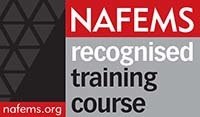CFDkn1 | State the general transport equation for a general flow variable. |
| CFDkn2 | State the Navier-Stokes equations. |
| CFDkn3 | State the Reynolds Averaged Navier Stokes equations. |
| CFDkn3b | State the general energy equation. |
| CFDkn4 | List typical boundary conditions for incompressible and compressible flow boundaries. |
| CFDkn5 | State the principles of best practice in CFD. |
| CFDkn6 | List in order of complexity the range of turbulence models for RANS modelling approaches. |
| CFDkn7 | List the main sources of error and uncertainty that may occur in a CFD calculation. |
| CFDkn8 | List and define the key terminology used in CFD applications. |
| CFDkn9 | Identify sources of archived experimental data for CFD validation. |
| CFDkn9 | List and define the range of common numerical grids found in CFD modelling. |
| CFDco1 | Explain the terms elliptic, parabolic and hyperbolic and the implications for solutions methods in the context of fluid flow. |
| CFDco2 | Compare and contrast the finite difference , finite volume and finite element discretisation methods. |
| CFDco3 | Explain the term continuum and state the limits of applicability of continuum assumptions. |
| CFDco4 | Explain why turbulence models are required and classify the range of models currently available. |
| CFDco5 | Review the terms in the differential form of the governing equations for fluid flow and explain their physical significance. |
| CFDco5b | Review the available turbulence models for RANS approaches and discuss their strengths, weaknesses and their applicability to a range of different flow conditions. |
| CFDco6 | Explain the consequences of the universal velocity distribution at the wall and its importance to the specification of wall boundary conditions for turbulent CFD applications. |
| CFDco7 | Explain the conflict between accuracy and computational efficiency when specifying outlet flow boundary conditions. |
| CFDco8 | Explain the difference between RANS and LES turbulence modelling approaches. |
| CFDco9 | Explain the basis of common solution algorithms in steady flows. |
| CFDco10 | Compare and contrast Direct and iterative solution methods for linear algebraic equations. |
| CFDco11 | Discuss the issues and conditions of numerical stability in the numerical solution of unsteady flow problems. |
| CFDco12 | Review the issues associated with the estimation of total uncertainty in a flow simulation. |
| CFDco13 | Review the range of idealisations that are required in applying CFD methods. |
| CFDco14 | Review the pros and cons of gridding approaches commonly applied in CFD methods. |
| CFDap1 | Demonstrate the ability to examine a range of flow phenomenon and employ appropriate fluid modelling approaches. |
| CFDap2 | Demonstrate the ability to apply discretisation techniques for diffusion, convection and source terms of the general transport equation using the Finite Volume and/or Finite Element techniques. |
| CFDap3 | Demonstrate the ability to apply boundary conditions correctly for external and internal incompressible flow problems. |
| CFDap4 | Demonstrate the ability to select appropriate numerical grids for incompressible and compressible flow problems in complex geometries. |
| CFDap5 | Demonstrate the ability to apply Boundary conditions correctly for external and internal compressible flow problems. |
| CFDap6 | Use best practice CFD methods to determine the steady state pressure and velocity distribution for incompressible laminar and turbulent internal flows using RANS approaches. |
| CFDap7 | Use best practice CFD methods to solve steady state internal compressible flows involving supersonic conditions. |
| CFDap7 | Employ best practice guidelines for the validation of a CFD model. |
| CFDap8 | Demonstrate the ability to prepare a comprehensive report on a CFD analysis. |
| CFDan1 | Analyse a fluid engineering problem and identify the limitations of the analysis. |
| CFDan2 | Determine whether the results from a CFD study meet the analysis objectives and comply with analysis assumptions. |
| CFDsy1 | Formulate an analysis strategy identifying, geometry simplifications, physical modelling assumptions, boundary conditions, material properties for laminar and turbulent flow problems. |
| CFDsy2 | Construct a strategy for the assessment of fluid flow design concepts using CFD methods. |
| CFDsy3 | Formulate a plan to address the uncertainty in input data or modelling when using a CFD code for a design study. |
| CFDev1 | Assess the suitability of databases to validate the accuracy of a CFD computation. |
| CFDev2 | Appraise the use of a range of different CFD codes for flow simulation problems. |
| CFDev3 | Assess whether a CFD solution can be decoupled from other phenomena. |



